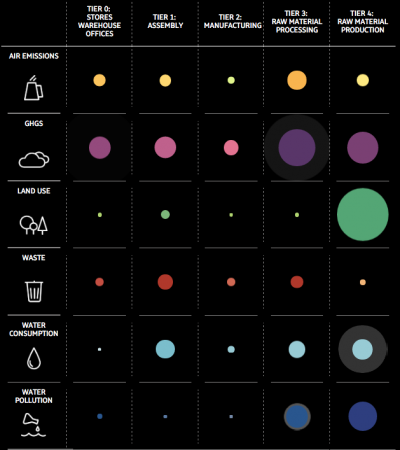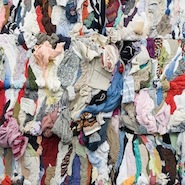NEW YORK – Sustainability’s business opportunities are abundant, but brands need to make it sexy to harness them.
A session at Fashion-Culture-Design on June 9 emphasized that the notion of “sustainability” in the industry doubles as a reference to sustaining a business as natural resources diminish. Despite the opportunities, however, brands need to convey the business opportunities to one another and quell the consumers’ notion of added expense.
“Sustainability for me is quality,” said Laurent Claquin, president of Kering Americas. “It’s also taking care of what’s around me, people and the planet, and from a business point-of-view, Kering believes that a sustainable business is a smart business, is an opportunity.
“If you integrate it early on into your operations and into your business, it creates economic and environmental and social values,” he said. “It’s more business, it’s innovation, it's cost-saving. We approach it from a business point-of-view.”
Making sustainability sexy
The word sustainability conjures abstract notions of climate change and pollution, whose effects are felt gradually instead of all at once, Nevertheless, the diminishing supply chains in the fashion world will contribute to financial hardship, and sustainability also represents a financial solution.
Kering has been a leader in orienting the fashion world to seeing sustainability as a business problem in addition to an ethical one. The conglomerate releases an annual environmental profit & loss statement that illustrates the monetary effect of its supply chain and distribution in relation to environmental impact (see story).

Kering E P&L grid
Among the premiere findings that Kering is sharing with the industry is that the supply chain is the source of both high costs and negative environmental impact in the fashion industry, and that the two are intrinsically related. As high quality leather, cotton, gold and other materials diminish in number, costs increase.
In addition to sustainable supplies having a more stable cost that will help businesses save money in the long run, organic resources also can offer more immediate financial gains. Organic cotton, for example, has 80 percent less impact than conventional cotton.
While conventional cotton may make for higher yields, the lower quantities of water and the absence of pesticides for organic cotton can help suppliers save money.
“It’s a very practical approach,” Mr. Claquin said. “It’s really protecting your own resources to stay in business, and that’s how everyone should approach it from a business point-of-view.”

Chopard Green Carpet earrings
Nevertheless, for consumers, style, fit and cost are more important than sustainability. For luxury consumers, sustainability is perceived as a compromise in quality; for aspirational consumers, it can be perceived as more expensive. Finding engaging ways to convey the relationship between sustainability and quality and its cost-saving opportunities is the critical next step for brands hoping to move the idea of sustainability from a boost in image to a boost in revenue.
Moreover, an increasing desire for sustainable goods has led to a proliferation of sustainable supply chains that were not there in past decades. As sustainability becomes a bigger part of the conversation, more of these supply chains will open up, leading to more competitive pricing.

Sergio Rossi Green Carpet Collection
“It goes back to: it’s price, it’s style, it’s fit,” said Matt Scanlan, founder of Naadam. “How do we interject this conversation into those decision whether or not you buy something? We are in fashion; at the end of the day, we sell clothing."
From top to bottom
Simply presenting a sustainable image in marketing efforts is not enough for consumers, who are increasingly skeptical of advertising. A sustainable focus must be present throughout a brand.
Strategic sustainability should be focused, starting from a brand’s interior before radiating outward toward consumers, according to panelists at The New York Times International Luxury Conference April 5.
Panelists during the “Strategic Sustainability” session agreed that for sustainability practices to work, brand employees must stand behind the company’s efforts. Employees are the best brand advocates available and can attest to a brand’s charitable initiatives and values as being authentic (see story).
Sustainability is a hot topic in fashion, but is integral to other industries as well. Automakers across all price points are producing more electric vehicles, and governments are pressuring them to continue advancing on this front.
Norway has announced that it plans to ban petroleum-fueled automobiles within a decade.
Several sources have now reported that politicians have reached a bipartisan agreement to ensure that all cars sold in Norway will run entirely on green energy by 2025. Norway’s small population and history of ecological progressivism make its ambition more feasible, but the development nonetheless points to trends in both the automotive and political spheres (see story).
“As it relates to fashion, sustainability is innovation,” said John Moore, co-founder and creative director of Outerknown. “It’s responsible innovation, and fashion is about innovation.
“You have to stay ahead of the game and bring newness to the market in an exciting, inspiring way, but I get excited when I think of sustainability as innovation,” he said.
{"ct":"9+UKBCLkTU1jYNuzzQarqPBuOqSheG\/LvxSMBDUSpELfRV6HR\/7a4nKJNjqhTyUtLoYhrTB5oYwV9Zog11iUph0QPmMk88z6Gm\/uhO05+UtZ\/DKtUEecQDyrdOYjq4MNJ7JOMOU8gQ4hpXiqTW2Ji5FHNBcfvOLonM69koxspRSOYuaGzTR9ra+QX+Ddz4a7aSgcYsicqxSAGCh7KS2f\/wb2iFjivVwuS1\/\/ovM54BQ0AhTFJHgM5lwc+uEjDkbZ075NxywhUmN1uSEJuSDZcoTjv9IMEtEUp46ud28um6asq0S1ftlQH7oLhNGin52nauxYlzw\/0XPOvL3lUcmauaOf8iOD2et6UV0Lbwb7zFSnV5Jt7QxWMZ9q9IWXc9kPP4slPIFTxaAX3+J8JtFel6DvsEArZLe9rjsv5tdTZsNIJsjkR6qu1Se5uotjZVnNRN1W7gdW\/ab+IKRHAj44h6tIzWxdAuit6ZlCCzkmQAHDn9XPbc0ovDM6wr\/rJhdfhwvm37W8SqZVAtG9GoL3Z5YaDTk5dTl3DABaMWACfBGlv6rNc1R9wfL2JWmrJ0qnaRvBjN19OlbJn63M05V0wdWLxKM2DFqI5nn7kjdsysduICxNajsRHcjFRiWpbGKfxWbVVt1Gw6q3H4zvupBQp3fKcopPUW32u9r88hiviP5c\/GNtmY3kwzws3a9tXPB2YLC\/k\/5UL2ConX7RKfjy58XBFHJLwoxaKfN+nzW\/jReNT88m2cj6pdTzuY75iAiDUmQdmjQ\/JnB2dpMsO58shKWtE2b3WMWhVoBQsoP0IRRPinlAFm9ChM+QNSaeAaYAJsMj35aio4E3LBAmGGiXEP0J6C5K4qI97X2dR4+3ze+IvV6VdKwxZvZ1xnIKAN+LuWQCjG65P0jLvjTJImsn4woqlSv4GmP05nzIj5klxFuKnKOzZNE2PLDRKGY9q4mnjP4ZDs7DWemNs6X30dQm9x\/HDpRB9ScGeTpEJ+LKUl+zkIJ+6DaDwYPO+QZy9sqrX4Gpv9cGpmiDdS2ZIDln86VAr5h2HfYgqhkYYhlQAxAqUuBn96kJK0qG8zqJa6N+rvy9y3chqVv\/\/LuywNAUse7A5fA8XWrMlW9exEBA+e1\/eIrJlXVdve0bsI8TYisuNpDabE2oR9AK8JePho1CHQYHnn8D8rrJNfJTCw+nrqRyQNFUoGjpYwEeEcQ7hn78nj6Uw5jOqv5oGYXUajlpkQxhmpE0ZXaqZlIPL49x8l2uQ2NtpE1oc\/ZFIEZA8rN+DRpJS44xlezFFUc3Ax\/2FRo9gxCJZGpzKBIdZknUWgUJvU9UlsDvky\/1Z\/W5bbMphQ5PMWGk4HVa1ULZsDItjsoh+dWet1CQiTtzn4NDMCrCLKPvK9MBSZGA3EFiEXwDqZZrT0qUDIMYtRs7or4JP6WUgzIXHlcabK2hSkD6ktDEN94Gy7P7YUF0eJKZo9H0qLzakvFfwjxz1IXEOIsrBipGzOx0lfTZUMvXWXPD40GpOojUQrxaJXPw3axjQLKhe8WAhrM4\/PayI\/ByibDs9AIMLgx8zX3Q1\/ydKDLOIIna9hjHJQ07JJ57IUeczSt2smIOvBjxIyw4tRCW4QsXCVcu84xkf8QicXNfx8H5iObPKSmySxZHhbu8uE7c9MopqwBHaaMZKTl0MnbMITakx\/lRT080QCK76MMLxfuJres19aT+xmTCkES+b6uAh7fEt0OxOzRTjFntCpO77YWdwmeLswXd3nOntYDQI\/bZw2Ry3w+2JMq7AuwISWKGBR5m+yln7CFF0vjQXFgwp3oLLPtIvb8ck0hqvM3YvSLZ1SvVOxo2eArbM50clmKCXiOpWiC13Xiv364znuZUrpYk1rTJZlkAHoDBF+bi1\/MlSFddBaP0ajXlj2HGnkqo8ehF0+JnMvLYZuZlRA6wZdZM5YgA0xP0dBJGr9mFYBB6h9+euvYkVZBwwrc3R2l9InThiukRoQl9OQgfHMRZ8iT3SqL4xTWUGtlBKszoUUBe8gViIdKQUT08buGcxYKc3VXZPDOZQC+ysO0T+g2BD8fswtjBZH4yQILgpatTzX2n7HZJA5\/15BgRp69kS\/0J1EjY\/pNIi8YLMUKwqIwhUsk73q3eD8txQnqhLGnNptSKnabhbqB3RwJgy14V7y4iZIdnZ3RfUuDTzp6s4bpx2BdRoEzFwvc8n+mz8cMCb5QemtUsK3eFQU9YIKd2Tb5i5yGSrpOwRn6RHAcsI3rwqhUdEBLtE7CIitiSKQAzeHh7BQhl1LapfHxUBlNOgpwP48XesrJ+SIESv\/fY6Be5MKWhSK71MUOhsOIs9+lviZOdoDXmro0MpQHnMoo6LMeqQE9tpRctlVBgMwU4gDcdG7uWq1ETW9WsYQlttEMbX4z+dARs7dD\/i+CH430z5HvfHQrEuvO6aSKOXvWyDOkDD3jPc2kBt4S1hWPJCI\/lE+yDHOjSgmSQOwgcorkkiYDfBaURK18c80TVPmJcM1MpnG+YvBpcpryDPOoUQXHqByjFXTJHqijqpqjgRIvzi93U8V7cZeAAVy5i1HiOX5EeAdN676iEhhNQyIe8PqWD59Ofya7ckauMgpDtMxNYqSeyQVVgpCNhXccbOtu0lyA2FIEY37ucbhHE6lB3vXexOJlIdkGcsQHUZM\/LxLX45AfHRMWDa3xIMAGG0ZT19d9KKJjENcpDDIhmRlRSTJOxOzRdyTuN2G1tlC20pM7iMjn8VKgCvZm2CMPUlTrKN+UzO1J4+wML4AHo8jehBHavhHBQsa5YDFyNmrWl6HdEHd0V\/pPvVuy+W\/mpC35yk4iC7j1UtIdP\/B\/SCMsfI7X+ivkSvef2iZbYV1vp4A4\/NDTUe1Oqa5m42WlyyYpbvL\/oF4q0bx1r1CDId+QuOhZrY4FLw9NprhaB04ZyYWXQ5KtfBInB5BiqO2atclopev7R+rpJQOLCUTb2irBiZ3P09IZapyT9M54MhqWv1zXAd0J2IlvJwBPyBwWElwx1hVQBE6prxlNrZR1CxObA4x3y2sAQkTCO2YHcXxw1nFte+aTIC06M2Kf4gy3q0lEC7fDcwSBoazcV\/PA3YTFwYTEDyvyfpkKLzFuSWyfyco+IHYANYRgC9FZ5Ehd\/YsHvpWyC3Tky2rzA\/ELPTMU0YmKhifKPnRUab0vmTwaj69bWPpLIvNVTNtz9LYoXjWcltw+EuqWcZhXsRSM7AgmvXQ3XEa2AeyvTjXhOJKPuvoNM76gzTm1bHxJwTi8sLplKNPK+tfE420mLamLVnKbug\/tA5AcgzIkZ6lR7eQTOQt\/8jZ7N8lwm3vnDl7igCuCUhfkWmOd0m9lY0FuIvxGIKfpGo\/fKb9YTx1UbveObdBcltj5q9KbB+tYI\/loH8jJCEjqL3TbDDihU\/NFPCZZg1TwQw2DJrwcbjIIrJywUT4qLvE0YwtWvRRNunao5dn2xX+YhNxb6Sa9a2zWUF7eBXvZCYKNCPE92Zq84tXOf5HkJciUHR7zcFTstGA2oTIte48pA209ooh+hmSR44+Td8ICKGnmP7nOQ7UQkgrV7CuctyWY7ulFdaZZb9\/G+ILTuLU0zD1jStN+qkXGI3llOyFYlSfB6yNRF9DUZOJ9CFTlnsc\/yy5lByuVqNuxq2MR3a7UglaV5cCeiT8ahkSv07zMSTX8plN7mHgq5efp4igu7XACzgymTWJRb+SvfzaDfVM+Dbm59iE98tyTzcbX6\/\/ArhE2lWsIy9VQQFvslxiUgaQysPQZM2CznV\/bitUjQh02dhEqze7CXvKwaPKE6VHby0ua61+84WyqTHZhDclDe6mhfRX9sA2oGkMbIn1c6dRuqS2sRFof+6bL\/4kI+a\/vxSgJGp6hbh1Gbx4Hc2\/23qsPX79KUAtmPDpp9T4h\/gfzRGyEz1vqWsS1bhtFM+zn8uV25EcBHB15dO8gCy8ftrlJU3l+tSsC8g5FoCh0xLpXtqkyu0jxGf9NEY18Yv\/gO3U3vhUa7FUBSrdXLL8W3vKTPprQzuJVg0Rdp9G7kJHTxsO9X2htfDPMCr4bKAYDCQYz424MEn4IUADRDIQGTKkqgGSwGKNpOqq42VUr8N9X+bjSR+84xnTLbyHd45WgkDRvHSq0YNbtyvRK2M61sdgzlowICESs+loUZzhxmNysQenKO3yX8vmYWmhqrSEVjZ7wZYRVZ\/dDtHm9wcJqRF95hIwySj53W5hQBB06DLOPvnvy2FA1QixTQzat88hza4H6ml5LYMMBTs4hnOjtAAFNlsTqskR68oBoA2Fg8HscSAxEeOCFR42Sl4SGiPIRKb0kyI+WO+UFMgHJiKhNsZSY1bhc38YK8BtjR13KyyN9gqr9gVNwkM42dNmwG2Oq0aWJT2Kw0ZhbVSTpB9k6r0KoN9p7x+VmyvfskfvorlagNAde6nzQymg8V0xBqBuqgRcw4NPLSL3MinaKQm24pBHrcUPf7jYKnNO5zwRKraNLBfztVlCZLOeE0mmSdsEz5ImUpDYQeNs9QaRkAFfGdV0iX5f6P9jsR9KzvthG6Bdc0aesmtFgzE9gQUmuhWuahbjag77fAShYnnU7yNgaAfaMpHC\/4lmyxAg4DKqPw4wR1mvaEwgED1\/eF4ZjMUvWHl9BuhYHiJJ+iFryy+OhTEy2my6IGoNoFkoUTBTDozQziSCFOacmB\/L16oebKVYf6Akg8Ai61Mdadjn2fKJ\/2a4c2X9pntREDmtN4Bpjec\/kdZ2eWFhXFfOUXUdlH8J\/dBlLregUmPQ0Z0gJJ7zlUj6qHxjaezIDF8Jnk8Nms1qplpOUFbqYyBhl6N1\/gt2JkUChHaqm+ToAzgLiykJw0BLfv\/9qEuLzGMHAq0qvZfVuQmqWwAJIo+ACoqD8+Re0472lq1CZ3eJzVZK5jREaQe7uWLod0B+Mkt1HRxRhGRVRuDLhdsGn8ej9lSJmZZSoQ3bihQ05jvhaRh\/M3o6FtMm4PKDSZZ9qVD2tHgWVKWbQYM1R7QKDRoRU9xslwjDB+m\/Sn4poUrdb0Ju+LQ9zGNqQf\/sDj1Z8p85gKV2SQT4IXhsPHeNJR\/Xn1LToo7zJQOab2lcqNPNy\/PBesB2rObQD1v05z5mxMtd6zN9ijATBI4fmtnhORQMASNrIGU3n9ZFgoT6IbyuqIqO5hCCwYVCa7IDiJDscqLkXIGPuUUmMB7N9u\/FkV9VFMolR8r5j1l5p\/4uyx0Ar4D1PIC+T+VwR7lHoeLOM34GfB8UhM\/67nQeUtZibVZsXBGhctrqWd04KUdYQeXUppeI\/MQVRtHRHvKNBL3bhZK+DQFyTIE12Tda\/tLR5xOp5Onb6MlbbYIY5QYb5ByCZ0ZdPpDRgq9sMx87nyUckqxzeqc4SgJpA8O91j0UC1OzdoHEv28r4ZR6sYvTqYXg3RG3kIMIczcq5gYwB41ToLvxUpjC6YXtF4oVRlqCd60qSYpqhDJrffNklaz4G4TWBr1+\/CblNxj3hz0oM9Awjk4mYiexmakC3+nhGk9LzdcbM85pexKyCVRckTHckfLEdWRTDODfs+qgzTCqW38pg6N7Ppwg+1KcmL05E3cJZsrKdUgQ0AP1ObI+KUltkD1+Il47bqc\/7EHhfcrBpxh7vM46dayX1ijaJucohxnKe+OqiKCH3wmYhrkf7cF9uPzL2nwqFkhUtSApXTkdKCIIFod2JkG1UEJqGrrTWnzib+9Z6JiMVCwdFLSbFSqNAcNsqb9haNNee0oi5q4HGkzWhNfkUiS+SFuyUHKug1aLuE4or\/3zTLyZj7r\/gJ02xDy15VLFEHGB0pOBKOVurJIf3IIIwOiRIEMQ6uIzr1pnI360O9p7m+JX7vyj8CVRaZuRpaIv96ATuVNE5QI+1hJsMfgsVvOmTLzwyOI08mBMfjMaAjlJbKf0HC7n3Mzf8kx2AgxsFNyFSQ3Lh42UQq7jxMm8q1lVheSESNaVBcmSEULqClw3ROqY04AmhqRWzXFu5o\/4KNDa7EeUZG1y8nZRvXxCXHfcuwhzeKyaK9WyD9SFTJVd5ctV+8Yu28wrFBf\/pZwc7m5KbGx7Fo4J9WQ49eLwzg+nLaWH+UCqQr1q+hojq7m1scIynbJJbzKfKEEWEcJ\/XgdUsV0CgmZIT9U71NDVvOLDYn3zv4CZrjr+hvscUV8GwXCM97g865RhXAdVeWTxPiBxS9cAtJoXTHRE5G+IgeWMUiIPLGeXEGm\/E\/PHGtiZfPxwPxxm8cROEfVogTPpz5tYZCKVyRBjjVVNIgll3Bkt9qayXLdxWib3AlBeoz\/DvyhERDx2CY2pu2PKopEwg\/Digz62tGiHADymJoWH\/TR+93GWBTl\/3Mb9na2YPRUdSD0Ddjo7IFB2H4S+dzmWyWgvLxlMDSuXaDI\/3oCYWU+kG2fN3heQHzQcxKVBVWMF9MUgP4JuGqcNiTtN7MuN\/r8z7K0Sq5xeJh6IFtKHI1FwGgHixw7rZk4G9r68lv0v+s8\/feVb3DbY5tRE\/HfeNYOedfW5CG0Af\/SBAKG3ZaJzoqLOk6vtUqB27gyfg\/aa\/6Ug6fsHscY3Vwxx79svxoZGo4k1XFJYSnH3sc8lkb1AuSXTRgXkFNzkhYCbGK0P5st1w0q2cIobKXDkt4ge2KyIc7M21MICLJsR09yJeWP18yvAITB97N4MHUFnbvNLpLS8xppi3zfTrKGisIszV9fM5Au2ZnKFZEq\/apFsQtWHJfJSyUoIxHixcZrAC2w5cNAI5rSurZwveta\/ZC70VXeWcUwb4FZDscxv5r1HmwCfsljYDgshL04JpV0xld9DtRWZ7BghTsrdJUkN+6yc2NpG4wApOE+c875iFM\/hzFXC\/63209tw6bhCrnHtOd9YPH3jBB5oHDJ8MK0Gbpc+iVKxLumqL2COzXS5kjQQARZr3UQ7qOCLerJmVMwLqwgbmtnAmEd5zHOp\/3KOvUIyUUdIutgc3UdpqQQrj6AyFS6K6gIK\/cf6aF99eeL9rJVuQ4AHeVpPPs1Dov7ouLwjI8YNOXO6q2h1ht+0ONeAGNnE8RgFjz95+D6BxUF5Y7WXlbFjd5sbcqJzKX2BkQur0qZqPWIaXq1VA2AfK7NgKR\/RLcH4+HkolukuQYIIYBxGNkdSLTnHgDs21icdxTFceHXJySU7M3I5w3WO9N3QeeZxV3dQYkv5p0RO6U5ab4UsukEJOFEtEHkHeas697vBJHGZeglrVF7RnZgiIZ+oZs\/iRh80zXMxSLpSUkEr3vaAYTstU\/aXKhv3lcUBFV01KbTG\/of2tDhbWGUI616Dh7OO1GIMkDGLIfGuNAyB9Nj\/FSFPi1YT2+6XKZs2R8tKxrfyBwKfevD9egBtuRgL3jX3qi42yr3DZ5xnpBCKub5ZbiA+1+Q4bY8jk15n3wY8JgCZv10yI05auGkuOslbg0deW+KVp\/udgFkxrwMz9QU2GPXzQY9cPB2W2IlTcJbqdcptz7EiwsxB4VWjOY5b+\/Uv3ZHN+ApJYBPBWDLTUjuaWGjhLNWHzDH7Sre+mCIPNyUqH4WPnZkNVDOt9+2GPDoIwrSuH9von3yHs9lT90cf\/MEE3dHuM+RlQkXRxlZ9q6ICd8uC2lTv5IrT3KomifnY7pXTaVNZMRka0p5XrTwR7j+t+6WN\/6nv+FXQ3qjsPVe55bS1MGjKglm2kvv54sG5iPx\/IenxkzgY7YcyIj3UhwGDdxbYbabrzbcVfUL1DCVhD+lsvYkYnGhbYpjgBX+vaYUoavEXUYD0wfWBL23Vwgk4cqOHnGrynUcMl9NTrf5W8FxO\/bV7qkSQ3ng5V0XopJYv3J+tqsHbQhKUIHrl9A6nqUxxFZYdiu3co0ABwCZUPgmES61NXJFA\/FmA\/uvwLLbVhqieIcP3K04QWp47IkNsZtFWY5QrtxHmZydZ7auA1kCasEdwm0pDkXXek8SZ5MNh\/1n\/jve7hDFNyVIvGyRkXZQAYsK3EpnSfdpy9eQw\/nzaG0S0KDgfa\/VjVfonTRBhcMKH3tuI0WqptR4bc+KWwpWkrBK5a9Nk7JBSyWTezE6+osvIW+nsQFIuN4fBv3lbFk01DGVZeEJ45NI5\/97M1mfTPj+Ll0cGGDILjAfACjbbOaQxJmtH1O7E\/vjC1zR\/P6Js\/z4T31rm6GqM4MGmxennUIAwGVmIPkXl5OsvV+Okl11zqGeW6YyASRqCqutTpyWpQnnTgzCtJ62baDJVP8IDkMB5nTNN3lao8HLV5JXT0FxrYqEwgazJSZcaVDAoaqM8rEpK6bpdUzIkgI2vohue99mhk97NaqoPCYJRQb1zYfXpcwHfc9x1lQ01CKfVsbQEKM\/ya1PtV0UCubYABOnxAs8LbBXqI2XLD4d+YCpCStQT9yt+ayCRWh8mmtk6L3ePGk0ig\/s2x1etyyLrkwP9CvBTKEQW9+YMbYGTzTuH0hX9MYOTcG1bb3zPA3spX7Bgt4JSmWJrCWFDcchVlQ9I58+UEFguc27RN1nBEgBEvn9kE8nf8WBPebyYTg7YBMnwgOI7wLsNXGt9E6izx4HusRbSHraSACMMgyQK5iwr48uJSt1op6vnutT+oQ9aXFDsPp\/LWULMxX3i6yk8aQigKyUjhxdMIIdYGGuAHj4d7Um3gc5NnvCqcM4s+xdoVv73i9ftJKddKGpDVGns5ApjGEwLvFRUrOI9woL60bibuO0RjPhb\/vqOWkQNNRsPzg3PlFP860uImy2DgsA\/7oGXTiETY7J+e2GX6q8iTe3ViuEOgSkFWbfFRIzBa7pC07KHW\/6kcER4QsgpMMAYSHKPPGvGoMXnAMAtHw4g5NngHva0gXvcIKbjawSvaESDNMAnc9iIYCrwsUurxjxBqRppW1FE8tgGduiyIdq\/Tdy\/tz3yvKUsX2YrqHWEylyYqUTiK9ndjU9ojGw4P+bznfeEeCEuEiZbdnGE8PifN3IhTOOkEunF9r2gTaNNNTPpgnoJfhAa9hkHigthwlU62D15+SORNbkVddkXGctj09ka5bWa+F3u2edTeswbG1sPZUjka8nAqceFGswlf4R51b2Xr\/Rk6OX7aMICgO4CRY3IhivXyR54XcrFH9FT\/xsm\/MBRHOmeOr3+cfdkZh\/QyTBdU5jdFXSVl0sAtzRpSTmpb3fSnX4T\/q\/Eyp2S0qLXPRfuTTvbJaGF8OV2wicvMXAuywno5MuxIwZl5VSHGF9KgMWdroFkuQs3pD9y9AMNFsOZpWSay\/YOB2xsqX+YL3TbKrUJQyepO8jh6VcQSJFyE1jdohbwqLbRmGdOtqOVCYGQMmvPma0hzMjUcu5zIdAeuo2kZgb1XSjbAZL20jed9zT+Zal1zR855Q2RWz3Ol7VRyTMSJnl44uUA\/pGBXwQuHj8gaPViQTi2NSacqkSt5CWT9\/2sAOp0y+WLDYw8HadfkjsmmwxZBYfIdvGSjFjw16k2aokS7rLWM\/Xv+cX8HggaGCA5h11QLVf+aHIl6irhpE5skdzjkWvDqjWGVfFktTjM0H4jPsYB5YFJw5t8yqebOXPAM9ld7A0T\/DbRj3l9GmFy3eU+jog6uCGTG+4i7w5bU9x3p4k1u9+7yMAV4JmaxWF2ErxaPOnvl4gwtI75Pf1p1uGReo+DJABmYyhWmSDWMiYGN2tZhTo6QINvV+dCcSaXe8lxhXtYPPdlwwOohOWFmoueikMhB5JwH6v2lsDHwf7SswpNjnHnHiojCfb1TLTfQUCVqgTgzh1X+XjHPwg33\/GAbUEJl\/YreAIMOMN14viz79bfg71hFQyydb8XPz1Obiyk3mclSLHyO7vvagtFaLqD3wqE2hyLPjTgTbRQRmfl1SZfmZUyzlHVYEHG3N6I\/NxouDeOGc6KGNAsfQrtRdhPXLWW6haquPswFo8vCUo3yZYjaR5LpIP31e6QYuZtKNElE3kk4Io\/dTHcB1d1noO+8rIgh7Xi6RhKERAs3gvgIeT+pTTU7bStfi5OvuoW29diB31a73GKurfe\/uqVO5uSqPRpJS2uK1+Bs2\/ol7XW+0GItoI+uew+lie93jq86dhFPoc8LBOMcmZf4WxEzenT8PcH\/o8M9P\/GnL9le70wgDuE3tDkxiHW0Kg0om3xiDxge0FyyShTRdpIYHH5tZRbsBmhEHGIhvIA1m31WKR6pejHLi+8iWW\/xFigUP9DnkVVo\/8zPxLsrJDn13om\/NdYyltd+CJwW4A3IK4kd9iHYX\/itgEbf\/9VJq\/oJJ","iv":"60d6d3264f22265722b944eb6a5b9f42","s":"2ccdde2dee7c8370"}

 Stella McCartney sustainable fabrics
Stella McCartney sustainable fabrics